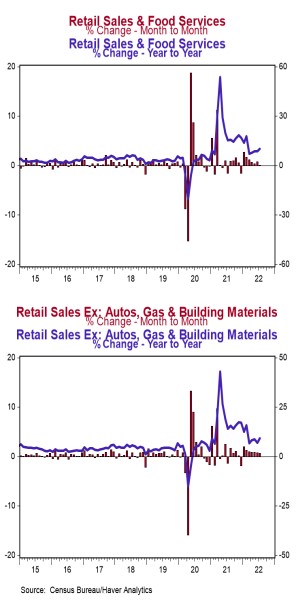- Retail sales were unchanged in July (+0.3% including revisions to prior months). The consensus expected a gain of 0.1%. Retail sales are up 10.3% versus a year ago.
- Sales excluding autos rose 0.4% in July (+0.9% including revisions to prior months), beating the consensus expected decline of 0.1%. These sales are up 12.3% in the past year. Excluding gas, sales rose 0.2% in July and are up 7.8% from a year ago.
- The largest gains in July were for non-store retailers (internet and mail-order) and building materials. The largest declines were for autos and gas stations.
- Sales excluding autos, building materials, and gas rose 0.6% in July, and including prior months’ revisions were up 1.4%. If unchanged in August/September, these sales will be up at a 5.7% annual rate in Q3 versus the Q2 average.
Implications:
Retail sales were unchanged in July, but the underlying details were much better than the overall headline number. Losses in four categories, autos (still can’t get enough inventory), gas stations (lower prices at the pump), general merchandise stores, and clothing & accessory stores (excess inventory leading to discounts) offset gains in the other nine categories. The largest gain was for non-store retailers, with a large chunk of this gain likely from Amazon Prime Day, which was held July 12-13 and which the company called “the biggest Prime Day event in Amazon’s history.” “Core” sales, which exclude the most volatile categories of autos, building materials, and gas stations, rose 0.6% in June, were revised up for prior months, are up 9.3% from a year ago, and up 28.6% versus February 2020. The problem is that one of the key drivers of overall spending is inflation. Yes, consumers are spending more, but they are not taking home the same amount of goods. Although retail sales are up 10.3% from a year ago, that pace barely outpaces inflation, with the CPI up 8.5% over the same period. Due to very loose monetary policy and the massive increase in government transfer payments in response to COVID, retail sales are still running much hotter than they would have had COVID never happened. However, loose monetary policy, which helped finance that big increase in government spending, is translating into high inflation, which is why “real” (inflation-adjusted) retail sales are up much less versus a year ago. This doesn’t mean overall consumer spending is down; “real” (inflation-adjusted) spending on services is also still rising. But it does mean overall real consumer spending growth is soft. What to expect in the months ahead? Gains in retail sales, but gains that struggle to keep pace with inflation. Meanwhile, look for modest overall increases in consumer spending due to the service sector, as consumers continue to shift their preferences back to services.





